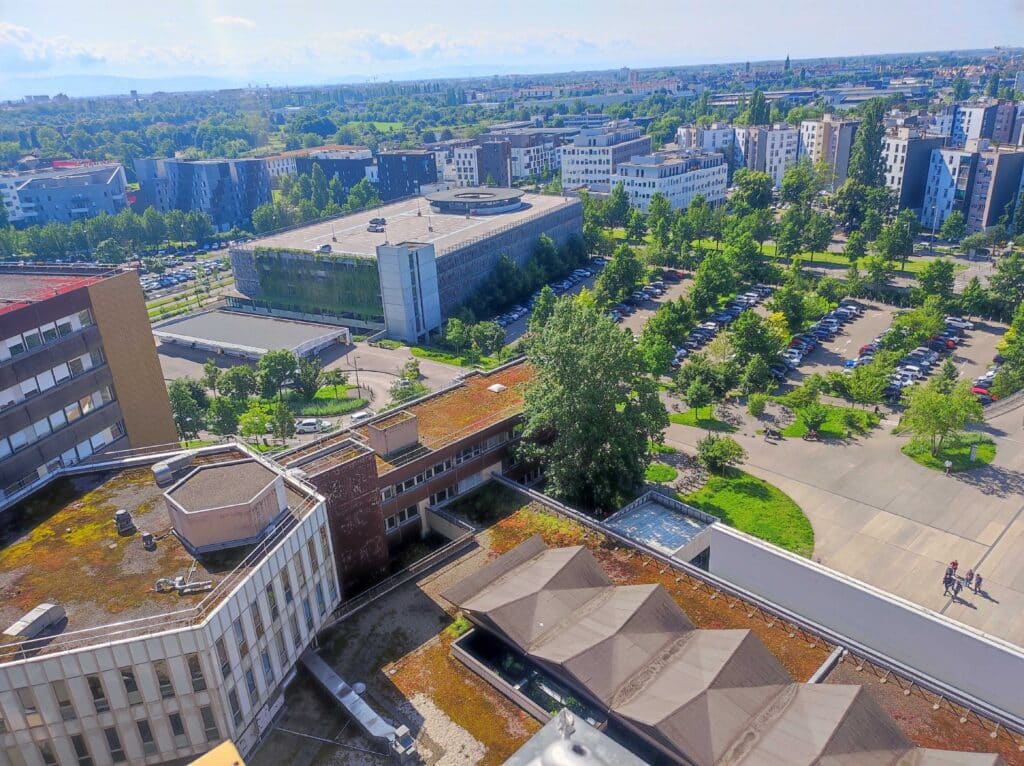Smart lighting represents a significant advance in energy management and the modernization of urban infrastructures. By optimizing energy consumption, offering ease of use and improving safety, these smart systems play a crucial role in the development of smart cities. To help you find your way around and make the right decisions, discover our smart city guide.

I. What are the challenges of connected, smart lighting?
Optimizing energy consumption
One of the main advantages of smart lighting is its ability to optimize energy consumption. This smart technology makes it possible to adjust light intensity according to actual needs, thus reducing unnecessary energy consumption. Signify BrightSites’ connected LED streetlights, used in many smart cities, automatically adjust their brightness according to the presence of pedestrians or vehicles, resulting in substantial energy savings.
Ease of use and customization
Smart lighting systems offer ease of use and total customization. Users can control lighting remotely via mobile applications, adjust light color and intensity, and create lighting scenarios tailored to their needs. The Philips Hue system allows users to control their lights via a smartphone app, changing colors and adjusting light intensity according to their preferences.
Improved safety
Smart lighting also helps to improve safety in both public and private spaces. Systems can be programmed to simulate a presence in the home by switching lights on and off at predefined times, thus deterring burglars.

Reduction of maintenance cost in public lighting
Smart lighting systems can monitor their own status and report faults or maintenance requirements, reducing maintenance costs and extending equipment life. Smart emergency lighting systems developed by companies such as Enel in Italy can check their operating status every two weeks and display the results on an LED screen, reducing maintenance costs.
Reduced environmental impact
By optimizing energy use and reducing maintenance requirements, smart lighting helps reduce carbon footprint and environmental impact. Smart systems also reduce light pollution by adjusting lighting to actual needs. Solutions from EGLO enable lamps to be programmed to come on only when needed, thus reducing energy consumption and environmental impact.
Comfort and well-being
Smart lighting enhances user comfort and well-being by providing the right lighting for every situation. The systems can adjust color temperature and light intensity to create specific atmospheres, promoting well-being and productivity. Schneider Electric‘s smart solutions, such as the FieldBus system, make it possible to create personalized lighting scenarios for different activities, improving user comfort.
II. The components of smart lighting

Sensor-based lighting: the connected floor lamp
These systems integrate various sensors to collect data and optimize operation. Air quality, noise and traffic sensors can be found integrated into street lamps. And in homes, motion or presence detectors will automate lighting.
Telensa ‘s smart street lamps incorporate pollution sensors, enabling cities to monitor air quality in real time.
Network-connected lighting (IoT)
These systems can be controlled remotely via mobile applications or voice assistants. This could be the centralized management of public lighting by municipalities. Otherwise, in a more residential context, the control of lights via smartphone, even when away from home.
Philips Hue smart bulbs can be controlled via an app, allowing users to manage their lighting remotely.
Smart adaptive lighting
This type of smart technology automatically adjusts to various environmental factors. In cities, streetlights adapt their intensity to the presence of traffic or pedestrians. And in homes, they can be adjusted according to natural light or room occupancy.
The Philips CityTouch system enables cities to regulate street lighting intensity according to actual needs, thus reducing energy consumption.
Smart energy-saving lighting
These systems are designed to maximize energy efficiency. LEDs are used for their energy efficiency and long life, often integrated into smart lighting systems to maximize energy savings. Lighting scenes can also be programmed to reduce consumption.
III. Examples of successful implementation of smart lighting projects

Los Angeles (USA), the world’s largest lighting modernization project
Los Angeles has carried out the world’s largest street lighting modernization project using smart LEDs. The aim was to improve energy efficiency and reduce costs. Since 2009, the city has replaced over 180,000 streetlights with LEDs, saving 110.45 GWh/year and reducing CO2 emissions by 65,358 tons per year (equivalent to taking 10,000 vehicles off the road in the USA). The program includes a remote monitoring system to optimize management and maintenance, enhancing night-time safety and quality of life. The first phase of the project (2009-2012) included the installation of 140,000 LED luminaires, exceeding initial targets. The second phase, launched in 2015, aims to connect all streetlights to a sophisticated management system and replace old poles with smart poles, including charging stations for electric vehicles. This program has reduced energy costs by almost 9.82 million USD per year, and saved over 2.5 million USD in maintenance costs.
The project was divided into two phases. The first phase (2009-2012), with an investment of USD 56.9 million, saw the installation of 140,000 LED luminaires and significant savings thanks to lower LED prices and the resale of old luminaires. The second phase, launched in 2015, was financed by two loans totalling 65.7 million USD and aims to connect all streetlights to a sophisticated management system. In addition, smart poles with charging stations for electric vehicles are also being installed.
Canberra (Australia), operation and renovation of the lighting network for a 7-year contract
VINCI Energies, via its Australian subsidiary Electrix, manages Canberra’s street lighting network thanks to a €37 million, seven-year energy performance contract, which began in May 2018. The project aims to renovate, operate and maintain over 80,000 light points, 50,000 of which will be replaced by LEDs, resulting in energy savings of 47%. It should also be noted that street lighting accounted for 40% of the ACT’s total electricity consumption. A smart control system will also be installed for real-time monitoring. The contract includes two major innovations: the CityApp application to facilitate maintenance and operation, and the BIMCity hypervisor for improved customer service and performance monitoring.
The project contributes to the Australian Capital Territory’s (ACT) goal of reducing greenhouse gas emissions by 40% by 2020 and achieving zero emissions by 2050, while encouraging smart city innovation. This is the first project in Australia to combine smart LED luminaires, a smart city network and global infrastructure management, marking a significant step forward in street lighting in the form of an energy performance contract.
Jaipur (India), smart lighting for energy savings
The project in Jaipur, India, aims to transform the historic city into a smarter, safer place thanks to Tvilight’s smart technologies solutions. Faced with pressure to improve services for residents and millions of annual visitors, the city has implemented smart street sensors and adaptive lighting controllers to reduce energy consumption, maintenance costs and CO2 emissions, while improving public safety.
In partnership with Cisco and Bajaj Electricals, Tvilight has integrated lighting solutions that automatically adjust brightness according to human presence, enabling energy savings of 72% and efficient remote management of the lighting infrastructure. This project contributes to Jaipur’s goal of becoming a connected digital city, improving the quality of life and safety of its citizens.

IV. What’s the budget and cost for a smart lighting project?
Budget and cost structure: beware of hidden fees
A smart street lighting project represents a substantial investment for local authorities, for a number of reasons. Firstly, the infrastructure required is complex and costly: it includes not only energy-saving LED luminaires, but also sensors, remote control systems and a robust communications network.
A smart street lighting project involves a number of hidden costs that can significantly increase the initial investment:
- Network infrastructure: Setting up a robust communication network to connect all smart lighting units represents a significant—often underestimated—cost.
- Management software and platform: Developing or acquiring specialized software to control and monitor the smart lighting system can be expensive.
- Staff training: Municipal teams need to be trained in the use and maintenance of these new systems, which generates training costs.
- Electrical network upgrade: Installing LED fixtures and sensors may require upgrading the existing electrical network, especially if it is outdated.
- Specialized maintenance: Smart systems require more technical maintenance, which can be potentially more expensive than traditional systems.
- Cybersecurity: Protecting connected systems from cyberattacks requires additional investments in IT security.
- Integration costs: Integrating smart lighting with other urban systems can result in additional expenses. Those include for instance traffic management or video surveillance
- Regular updates: Both software and hardware require frequent updates to remain efficient and secure, representing a recurring cost.
Although these costs may seem high, it is important to note that smart street lighting can generate significant savings in the long term, notably by reducing energy consumption by up to 65% and cutting maintenance costs... However, an in-depth analysis and diagnosis of the existing network is essential. Indeed before embarking on such a project, we need to ensure its profitability.
Budget examples for smart lighting and connected streetlight projects
| Project | Estimated Cost | Description |
|---|---|---|
| Los Angeles | USD 56.9 million (phase 1) USD 65.7 million (phase 2) | Replacement of city lighting. |
| Canberra | 37 million euros | Monitoring, management and replacement of street lighting throughout the Canberra region. |
| Washington DC | USD 309 million | Modernization and switchover to LED of the city’s 75,000 streetlights. |
V. Examples of smart lighting players
Suppliers of smart solutions for lighting
| Actor | Role |
|---|---|
| Philips Lighting (Signify) | Supplier of smart solutions for lighting |
| Osram | Manufacturer of LEDs and lighting systems |
| General Electric (GE) | Connected lighting solutions |
Suppliers of connectivity and communication solutions
| Actor | Role |
|---|---|
| Silver Spring Networks | IoT network provider |
| Tvilight | Remote lighting management solutions |
| Cisco | Provider of IoT networks for smart lighting solutions |
Smart lighting solutions integrators
| Actor | Role |
|---|---|
| Vinci | Installs and maintains lighting networks Integrates smart solutions from partners |
| Eiffage | Installs and maintains lighting networks Integrates smart technologies from its partners Has its own brand for deploying smart city solutions, Expercité |
Wrapping up
Smart lighting is revolutionizing energy management, enabling optimized consumption and greater lighting customization. These smart systems adjust light intensity to actual needs, improve safety, reduce maintenance costs and minimize the environmental footprint. As is often the case with smart cities, approaches vary widely, as do solution budgets. This is also the case for smart parking sensors.
Through sensor-based technologies, IoT networks and energy-saving solutions, this smart technology is emerging as a key component of smart cities. Successful projects such as those in Los Angeles, Canberra and Jaipur illustrate the significant benefits of these technologies, although challenges remain. With the right investment and effective management, smart lighting promises to transform our urban environments over the long term.


